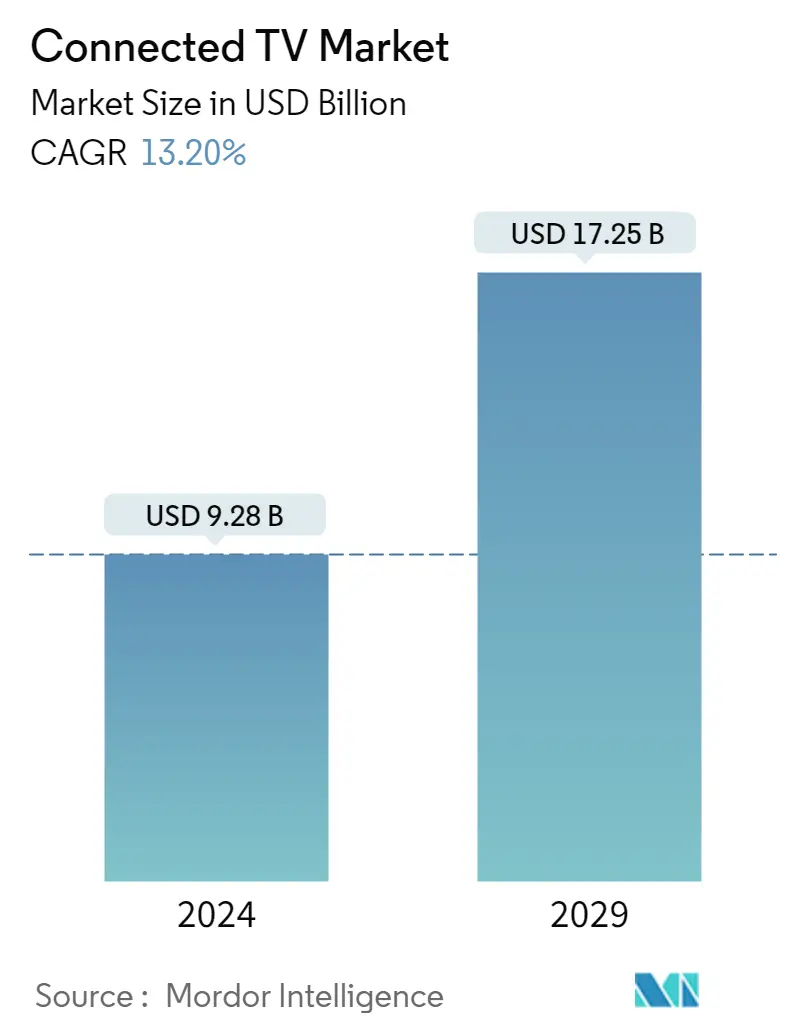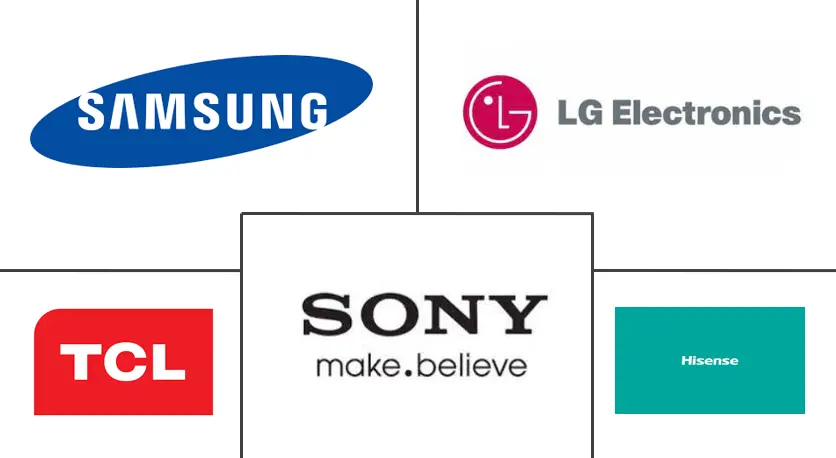Market Size of Connected TV Industry

| Study Period | 2019 - 2029 |
| Market Size (2024) | USD 9.28 Billion |
| Market Size (2029) | USD 17.25 Billion |
| CAGR (2024 - 2029) | 13.20 % |
| Fastest Growing Market | Asia Pacific |
| Largest Market | Asia Pacific |
Major Players
*Disclaimer: Major Players sorted in no particular order |
Connected TV Market Analysis
The Connected TV Market size is estimated at USD 9.28 billion in 2024, and is expected to reach USD 17.25 billion by 2029, growing at a CAGR of 13.20% during the forecast period (2024-2029).
As they offer a wide range of innovations that are unavailable with standard CRT TVs via internet services, networked smart televisions will be accountable for transforming the television industry. The TVs are equipped with Wi-Fi or Ethernet ports to allow users to remain connected to the Internet.
- Streaming media such as Apple TV, Amazon Fire TV, and Google Chromecast is changing consumers' viewing habits. Several manufacturers collaborate with OTT (over-the-top) content and device suppliers to deliver built-in functionality without needing a set-top box. TCL Corporation, for instance, worked with Roku Inc. on the launch of a 4K HDR TV.
- Moreover, TV manufacturers are competing with each other for the latest advances in user interfaces, content aggregation, and application development. For example, smart TVs come equipped with an operating system that's capable of running applications or widgets for streaming videos and music. A range of advanced computing capabilities and connections with common internet capability is provided by intelligent TVs. It enables consumers to find, talk, explore, share, make updates, and download multimedia content on Smart TVs, driving demand for connected televisions.
- In addition, the rapid global digitization of media has replaced traditional TV screens with digitized and smarter alternatives that have further stimulated market development. Moreover, demand for smart connected TVs has been increasing in countries such as the United States due to rising consumer per capita incomes and easy availability of products.
- Furthermore, market growth increases are being fueled by an increase in the importance of Smart TVs to the Internet of Things ecosystem due to features like ambient intelligence, automated user assistance, and increasing consumer disposable income.
- Due to their resemblance to a computer or a smartphone, linked TVs might crash and freeze. Customers' growing worries about data breaches and unauthorized access to the camera or microphone by internet connectivity may restrain the market expansion for connected TVs during the assessment period.
- The COVID-19 pandemic drastically affected the lifestyles of all consumers and the way they lived; as a result of sheltered orders and work-at-home mandates, video consumption in households reached an all-time high. As more and more consumers looked to keep consuming streaming content on larger screens in their homes, the increasing number of mobile users in developing countries was a major driver for smart TV.
Connected TV Industry Segmentation
A connected TV is any television set connected to the internet, most commonly used for streaming video. A smart TV can be connected via a set-top box, TV stick, or even a game console. Moreover, connected TVs refer to devices connected to the internet and allow viewers to stream videos and music and browse the web.
The connected TV market is segmented by device (smart TV, streaming media player) and geography (North America, Europe, Asia-Pacific, Latin America, and the Middle East and Africa).
The market sizes and forecasts are provided in terms of value (USD) for all the above segments.
| By Device | |||||
| |||||
| Streaming Media Player - Market Overview and Estimates (in million units, 2020-2027) |
| ***By Geography | ||||||
| ||||||
| ||||||
| ||||||
| Latin America | ||||||
| Middle East and Africa |
Connected TV Market Size Summary
The connected TV market is poised for significant transformation, driven by the integration of internet services and smart technologies that surpass traditional CRT televisions. These networked smart TVs, equipped with Wi-Fi or Ethernet ports, are reshaping the television industry by offering advanced features such as streaming media capabilities and enhanced user interfaces. Manufacturers are increasingly collaborating with over-the-top (OTT) content providers to embed functionalities directly into TVs, eliminating the need for separate set-top boxes. This trend is further supported by the rapid digitization of media, which has led to a shift from conventional TV screens to smarter, digitized alternatives. The growing demand for smart connected TVs is fueled by rising consumer incomes, increased internet penetration, and the expanding Internet of Things ecosystem, which emphasizes features like ambient intelligence and automated user assistance.
The market is experiencing robust growth, particularly in regions like Asia-Pacific, where rising disposable incomes and the popularity of OTT platforms are driving sales. The transition from traditional to smart TVs is evident in countries such as India, where government initiatives and increased broadband access are accelerating market expansion. Key players in the industry are investing in emerging technologies to maintain a competitive edge, with companies like Xiaomi, Roku, and LG Electronics launching new models featuring advanced capabilities. The availability of multiple streaming devices and the integration of voice command and computational intelligence are further enhancing consumer experiences. Despite concerns over data security and potential technical issues, the connected TV market presents a promising investment opportunity, with significant growth anticipated in the coming years.
Connected TV Market Size - Table of Contents
-
1. MARKET INSIGHTS
-
1.1 Market Overview
-
1.2 Industry Stakeholder Analysis (Smart TV Manufacturers, Middleware providers, Streaming Media player vendors, Suppliers/Distributors, End-users)
-
1.3 Connected TV - Technology Landscape (Smart TVs, Streaming Players, Gaming Consoles (for streaming)) - includes a market estimates and geographical view of the gaming consoles
-
1.4 Industry Attractiveness - Porter's Five Forces Analysis
-
1.4.1 Bargaining Power of Suppliers
-
1.4.2 Bargaining Power of Buyers
-
1.4.3 Threat of New Entrants
-
1.4.4 Threat of Substitutes
-
1.4.5 Intensity of Competitive Rivalry
-
-
1.5 Assessment of the Impact of COVID-19 on the Market
-
-
2. MARKET SEGMENTATION
-
2.1 By Device
-
2.1.1 Smart TV
-
2.1.1.1 Smart TV Market Overview and Estimates (in million units, 2020-2027)
-
2.1.1.2 Smart TV Market breakdown by key OS (Android, Tizen, WebOS, Roku, Firefox, etc.)
-
2.1.1.3 Key shifts and trends in Smart TV Resolution - 4K, Ultra, 8K, etc.
-
-
2.1.2 Streaming Media Player - Market Overview and Estimates (in million units, 2020-2027)
-
-
2.2 ***By Geography
-
2.2.1 North America
-
2.2.1.1 United States
-
2.2.1.2 Canada
-
-
2.2.2 Europe
-
2.2.2.1 United Kingdom
-
2.2.2.2 Germany
-
2.2.2.3 France
-
-
2.2.3 Asia
-
2.2.3.1 China
-
2.2.3.2 India
-
2.2.3.3 Japan
-
2.2.3.4 Australia and New Zealand
-
-
2.2.4 Latin America
-
2.2.5 Middle East and Africa
-
-
Connected TV Market Size FAQs
How big is the Connected TV Market?
The Connected TV Market size is expected to reach USD 9.28 billion in 2024 and grow at a CAGR of 13.20% to reach USD 17.25 billion by 2029.
What is the current Connected TV Market size?
In 2024, the Connected TV Market size is expected to reach USD 9.28 billion.

